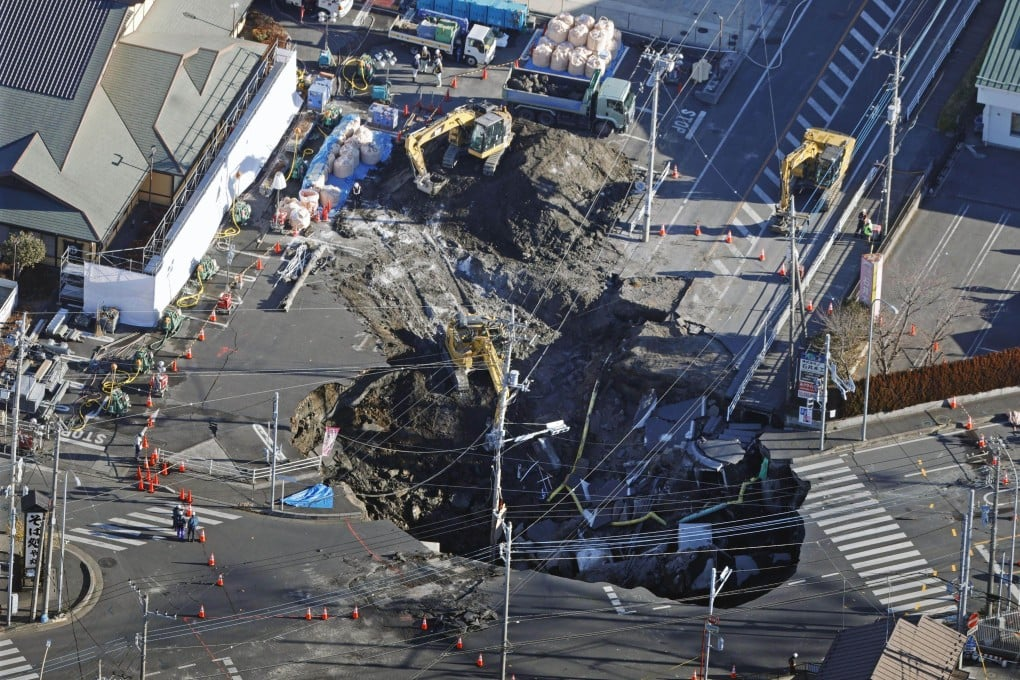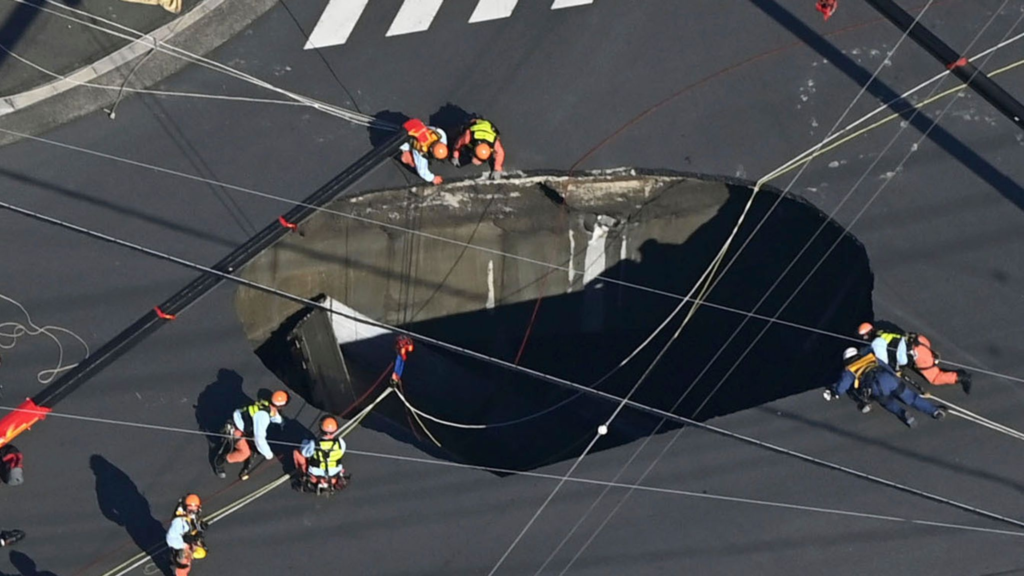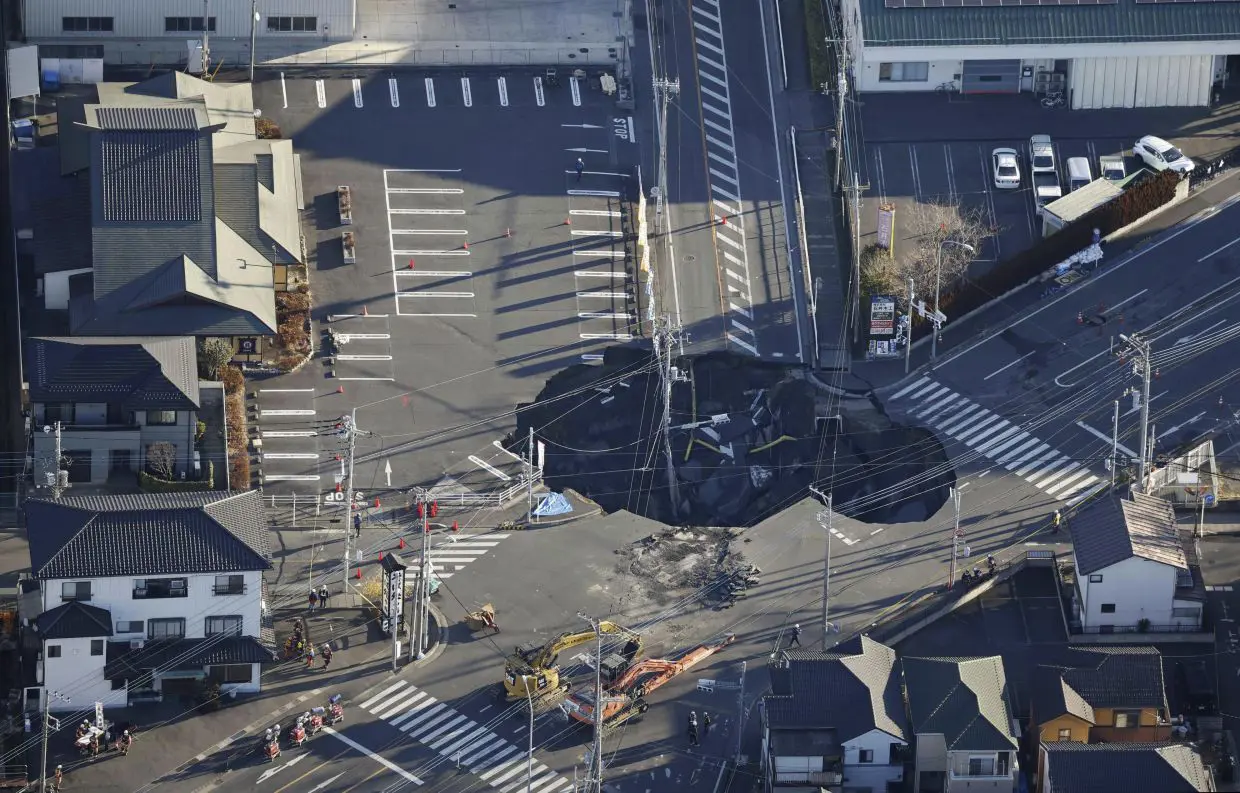A massive sinkhole resembling the size of an Olympic swimming pool opened up in Yashio, a city just north of Tokyo, swallowing a truck and its 74-year-old driver.
Since the incident occurred on Tuesday, emergency crews have been racing against time to rescue the man, but their efforts have been hindered by the unstable and continuously expanding cavity. The case has sent shockwaves across the region, exposing the dangers posed by aging urban infrastructure.
The Incident: A Sudden and Terrifying Collapse
The sinkhole first appeared on Tuesday morning, initially measuring about five meters in diameter. Witnesses at the busy intersection watched in disbelief as a truck driven by the elderly man disappeared into the earth.
By Thursday, the sinkhole had grown to a staggering 40 meters (130 feet) across and about 10 meters (30 feet) deep, making rescue operations increasingly perilous.
Officials have linked the collapse to corroded sewage pipes, which likely allowed soil and surrounding debris to erode, creating a hollow void beneath the surface. Tetsuji Sato, the local fire chief overseeing the operation, described the situation as “extremely dangerous.”
Groundwater seepage and unstable inner walls of the sinkhole have further complicated rescue efforts, forcing authorities to rethink their approach to reaching the victim.
Read : Hayato Kawamura Buys 200 Abandoned Homes in Japan, Now Earns 140 Million Annually
Despite the enormous challenges, rescuers have worked around the clock to construct a 30-meter-long slope to access the sinkhole from a safer location.
Rescuers are racing to save a man swallowed by a massive sinkhole in Japan while driving a truck through an intersection, with a second sinkhole opening up and residents ordered to evacuate amid fears of further collapse. https://t.co/kVX8aNrlSo pic.twitter.com/4MXg9MonzD
— The Washington Post (@washingtonpost) January 29, 2025
However, the operation is progressing slower than expected due to the fragile conditions of the eroding cavity. Heavy machinery cannot be placed near the chasm as chunks of asphalt continue to crumble into the pit, making even the surrounding area a hazardous zone.
The Human Toll: Fear and Frustration
The impact of this unfolding disaster is not just physical but deeply emotional for the residents of Yashio. The absence of communication with the trapped driver since midday Tuesday has left both his family and the community in a state of anguish.
The truck’s cabin, now buried under layers of debris and soil, offers little hope of survival, but rescue crews remain determined to recover the driver and provide closure to his loved ones.
The incident has also stirred fear among locals, many of whom are avoiding the area due to concerns over further collapses. “I’m scared to go nearby,” said Takuya Koroku, a local factory worker. Others have expressed frustration over the pace of the rescue operation, questioning whether a quicker response could have changed the outcome.

Adding to the distress is the strain on local utilities. With the risk of sewage leakage into the sinkhole, authorities have urged the city’s 1.2 million residents to conserve water by limiting showers, laundry, and other activities. This has disrupted daily life, further emphasizing the far-reaching impact of the incident.
Urban Challenges: Aging Infrastructure and the Risks Ahead
The Yashio sinkhole highlights a growing issue in urban areas worldwide: the vulnerability of aging infrastructure. Preliminary investigations suggest that decades-old sewage pipes likely corroded, allowing surrounding soil to flow into the pipes and creating an underground void. Over time, this cavity expanded until it could no longer support the weight of the surface, leading to the catastrophic collapse.
This is not the first time Japan has faced such an incident. Sinkholes have occurred in various parts of the country, often linked to aging infrastructure or construction activity. However, the scale and location of the Yashio sinkhole—at a busy urban intersection—make it particularly alarming.
The challenge of maintaining infrastructure in densely populated areas is a complex one. Aging pipes, roads, and buildings require continuous monitoring and maintenance, but such efforts are often hindered by budget constraints and competing priorities.
The Yashio disaster serves as a stark reminder of the consequences of neglect, urging authorities to prioritize inspections and repairs to prevent similar tragedies.

In the meantime, rescue efforts in Yashio continue under dangerous conditions. Officials hope to complete the access slope in the coming days, but the situation remains precarious. The inner walls of the sinkhole are still eroding, and rescuers can only spend limited time inside due to the risk of further collapses.
The sinkhole in Yashio has become a symbol of both human vulnerability and resilience. As rescue crews work tirelessly to recover the 74-year-old truck driver, the incident has exposed critical weaknesses in urban infrastructure and the urgent need for preventative measures.
For the people of Yashio, the tragedy has disrupted daily life and instilled a sense of fear, but it has also highlighted the importance of community and cooperation in the face of disaster.
As the rescue operation continues, the hope remains that lessons learned from this incident will lead to meaningful changes in urban planning and infrastructure management, ensuring the safety of future generations.

